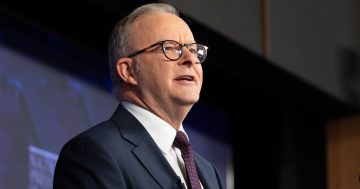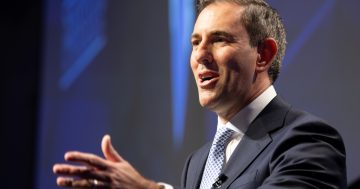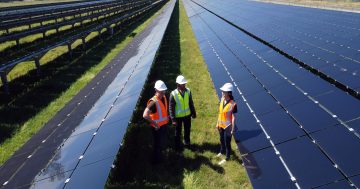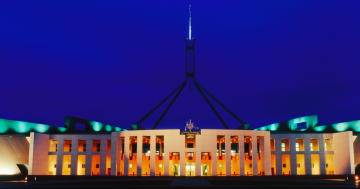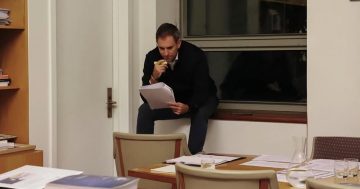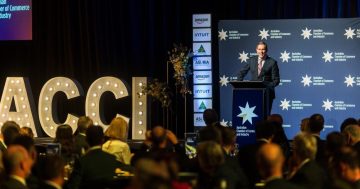
Finance Minister Katy Gallagher and Treasurer Jim Chalmers with budget papers in hand. Photo: Andrew McLaughlin.
Cost-of-living help, more homes and a future made in Australia are the federal budget features on which the Albanese government is pinning its hopes for re-election.
Along with the foreshadowed tax cuts for all working Australians, the budget delivers a $300 energy rebate for everyone from July and cheaper medicines.
Treasurer Jim Chalmers used his budget speech to parliament tonight (14 May) to emphasise measures that have already been announced. He described the government’s strategy as providing a “comprehensive cost-of-living plan” with a tax cut for all Australians.
He flagged an expected surplus of $9.3 billion this year – the second successive surplus since 2007-08 – which is $10.5 billion better than was predicted at December’s mid-year economic outlook.
But it’s downhill from there, with worse-than-expected deficits projected for the next two years.
The 2024-25 deficit is forecast to be $28.3 billion.
An overall subdued global economy has brought uncertainty to Australia, combining with domestic cost-of-living pressures and higher interest rates to slow the economy.
Growth is forecast to be just 1.75 per cent this financial year and 2 per cent next year.
That means a softer labour market, with unemployment expected to rise to 4.5 per cent next year.
“I want Australians to know that despite everything coming at us, we are among the best-placed economies to manage these uncertainties and maximise our opportunities,” the Treasurer said.
“We have an envied combination of moderating inflation, record new jobs, near-record participation, real wages growth, the lowest-ever gender pay gap, and expanding business investment.”
Dr Chalmers said that while the budget displays equal measures of relief, restraint and reform, its number one priority is helping Australians with the cost of living.
He said it provides responsible relief that eases pressure on people and directly reduces inflation.
“The comprehensive cost-of-living plan in this budget delivers a tax cut for every taxpayer, provides new power bill relief for people and small businesses, freezes the cost of medicines, makes student loans fairer, boosts competition in our economy so families and farmers get a fairer go, and supports renters,” the Treasurer said.
A $3.5 billion package will provide energy bill relief. All Australians will receive the $300 rebate (via credits to their bills), and one million small businesses will receive even more.
Also, from July, all 13.6 million taxpayers will get their promised tax cut, with 84 per cent getting more than they had been promised under the previous government.
About $3 billion is directed toward cheaper medicines and help for the community pharmacies that distribute them.
The government is freezing the maximum cost of PBS prescriptions, ensuring no pensioner or concession cardholder pays more than $7.70 for the medicine they need, and no one at all will pay more than $31.60 for a script this year and next.
$3 billion is being wiped in student debt for more than three million Australians, and the Commonwealth Rent Assistance is being injected with $1.9 billion to increase the maximum rates of help by a further 10 per cent.
The budget outlines a plan for 1.2 million more homes across Australia within five years from this July.
“Our goal is ambitious but achievable if we all work together and if we all do our bit,” the Treasurer said.
With a new investment of $6.2 billion, the government’s overall $32 billion Homes for Australia plan aims to clear local infrastructure bottlenecks, provide more housing for students, and fund more social and affordable housing.
The government is hanging much of its hopes on the Future Made in Australia plan, which aims to bring new jobs and bolster communities across the nation.
A $22.7 billion investment over the next decade seeks to build new technologies, support groundbreaking renewable energy projects, back Australian ideas and science, and invest in more regional jobs.
The Treasurer said the best opportunities for Australia and its people lie at the intersection of industry, energy, skills, and the ability to attract and deploy investment.
“The story of Australia is more than a tale of challenges we have endured, and in our future, we must strive for more than muddling through or making do,” Dr Chalmers said.
“This budget shows we are realistic about the pressures people face now and optimistic about the future.
“It reflects our biggest ambitions and our highest aspirations – to make Australians the primary beneficiaries of a world of churn and change.
“Tapping their confidence, compassion, and creativity. To manage their pressures and maximise our advantages. To forge a new economy and a new generation of prosperity. And in that effort, to make Australians and Australia more secure – In the bigger opportunities we shape, and the future we make, together.”
Original Article published by Chris Johnson on Riotact.








